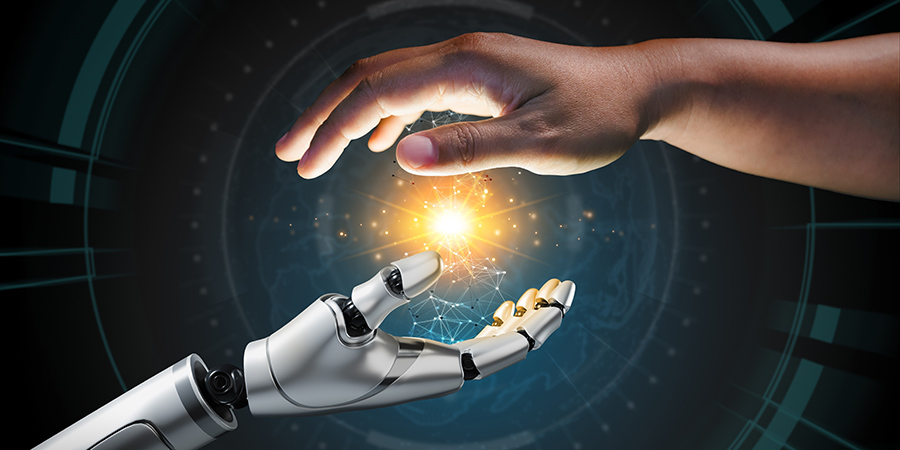As the Asia Pacific region continues to advance in technology and innovation, the future of human-machine interfaces (HMIs) is set to play an essential role across industries. This evolution will profoundly impact sectors such as healthcare, manufacturing, and smart cities, where collaborative robotics, AI, and extended reality (XR) are reshaping how humans interact with machines.
Notably, the global human-machine interface market was valued at USD 5.8 billion in 2023 and is projected to reach a market size of USD 11.37 billion by the end of 2030, illustrating the increasing demand for smarter, adaptive interfaces.
Interesting Read: Linking Human Brains to Computers
Current Trends Shaping HMIs
Asia-Pacific countries are at the forefront of shaping HMIs through innovative concepts like Society 5.0 and Industry 5.0. Japan, in particular, is leading the way with Society 5.0, a vision for a super-smart society that leverages AI, IoT, and robotics to address social challenges and create human-centered solutions. Industry 5.0 builds on this by promoting enhanced collaboration between humans and machines, especially in manufacturing, where robots and humans work together efficiently. This integration capitalizes on the precision and speed of machines, complementing human creativity and problem-solving skills.
Industry 5.0 is emerging as a human-centric, sustainable, and resilient manufacturing paradigm aimed at enhancing the collaboration between humans and machines, particularly through the integration of advanced technologies like AI and robotics. It emphasizes the importance of worker welfare and adaptability in production processes, addressing the limitations of Industry 4.0, which primarily focused on efficiency and automation.
Whereas Society 5.0, proposed by the Japanese government, envisions a super-smart society that harmonizes economic growth with social problem-solving through the integration of cyberspace and physical space. While both concepts prioritize human well-being and aim to create a more sustainable future, Industry 5.0 specifically focuses on transforming industrial practices, whereas Society 5.0 encompasses broader societal challenges.
Also Read: Building Brain-Inspired Networks for the Future
In the healthcare sector, the Asia Pacific is experiencing a major shift due to advancements in AI and robotics. Robots are assisting in surgeries, providing accuracy that minimizes human error, while telepresence robots enable remote healthcare services, making diagnostics and treatments accessible to remote and underserved populations. Countries like Japan and South Korea are particularly advanced in incorporating robotics into their healthcare systems, revolutionizing patient care and medical practices.
Personalization and customization in HMIs are also becoming crucial in the region. AI-driven algorithms allow machines to adapt to individual preferences, making interactions more intuitive and tailored to users' needs. These personalized interfaces are transforming everything from user experience in technology to the way smart cities function. In countries such as China and Singapore, where smart city initiatives are gaining momentum, this trend is expected to fuel the growth of consumer technologies and more responsive public service.
AI-driven personalization is one of the most transformative trends, enabling HMIs to adapt to user behavior, providing predictive and personalized experiences. China-based Baidu’s AI-powered DuerOS platform, used in smart speakers and home devices, enables intuitive voice interactions.
Telecom Review Asia Exclusive Interview: From Data-Driven Solutions to Intent-Based Operations
Another key trend is the rise of touchless and gesture-based interfaces, spurred by the COVID-19 pandemic. These interfaces are becoming prevalent in industries like automotive, healthcare, and consumer electronics. In Japan, Fujitsu has developed gesture-controlled systems for operating rooms, allowing surgeons to interact with medical imaging without touching surfaces, reducing the risk of contamination. Additionally, voice-activated HMIs are transforming consumer electronics, with Samsung's Bixby assistant leading voice command integration into smartphones, TVs, and home appliances across the APAC region.
Advanced technologies such as brain-computer interfaces (BCIs) and biometric emotion recognition are pushing the boundaries of human-machine interaction. BCIs, like Neuralink’s neural signal technology, enable users to control machines directly with their minds, offering new possibilities for individuals with disabilities. In parallel, emotion recognition, such as Affectiva’s technology in vehicles, monitors driver stress and fatigue to adjust settings and improve safety. Notably, the global biometric system market size is expected to grow from USD 42.9 billion in 2022 to USD 82.9 billion by 2027, at a CAGR of 14.1%.
Augmented reality (AR) and virtual reality (VR) are also revolutionizing HMIs by creating immersive environments for industries such as manufacturing, healthcare, and education. Boeing’s AR-powered HMI, used in aircraft assembly, has reduced error rates by 50% and assembly time by 25%.
Finally, the convergence of multi-modal inputs—combining voice, touch, gesture, and visual interfaces—enhances user experience and accessibility. Xiaomi’s smart home ecosystem, powered by its AIoT platform, integrates these input methods for a seamless user experience across its devices.
As these technologies advance, HMIs will continue to deliver more adaptive, context-aware, and immersive experiences across industries.
Read More: Tech Innovations for Humanitarian Relief and Assistance
Challenges in Implementing Advanced HMIs
The development of advanced HMIs in the Asia Pacific region comes with several challenges despite its many benefits. One major concern involves ethical considerations and privacy. As machines gain more autonomy, issues of accountability and transparency become more prominent. For example, AI-powered systems, such as those in autonomous vehicles or healthcare robots, introduce difficult questions in terms of responsibility in cases of errors or malfunctions. Furthermore, the region faces rising privacy concerns as AI-driven interfaces collect vast amounts of user data. This raises significant issues regarding user consent, data security, and potential misuse, particularly in countries with expanding surveillance systems.
Another key challenge is the technological gaps and infrastructure disparities across the region. While technologically advanced countries like Japan, South Korea, and China lead in adopting robotics and AI, other developing nations lag behind due to inadequate infrastructure. A lack of access to high-speed internet and modern hardware in some areas slows the adoption of next-generation HMIs, creating a digital divide within the region.
Read More: Navigating Opportunities and Challenges in Asia’s Digital Economy
The Role of 5G in the Future of HMI Development
The combination of AI and 5G technology is expected to serve as the backbone for the future of HMIs. The speed and low latency provided by 5G networks enable real-time interactions, making advanced applications like autonomous vehicles and remote surgery feasible.
China is leading these advancements with companies like Huawei developing 5G-powered AI applications, including remote surgery systems that allow real-time operations across distances. These initiatives are part of China’s broader AI and 5G strategy, which is revolutionizing smart factories and manufacturing through enhanced robotics and automation, offering faster, more precise production capabilities.
In South Korea, SK Telecom and KT Corporation are pushing the boundaries of AI and 5G, particularly in smart cities and transportation. SK Telecom's AI-powered 5G systems for autonomous vehicles enable real-time communication between cars and their environments, enhancing safety and traffic management. On a national level, South Korea’s Digital New Deal is building a comprehensive AI-based 5G infrastructure, enabling real-time HMI applications across industries like healthcare, manufacturing, and smart grids.
Singapore’s Smart Nation initiative is another example of how AI and 5G are being utilized to enhance HMIs in public services and urban infrastructure. Partnering with Singtel, the government is using 5G networks to power smart traffic systems, autonomous vehicles, and AI-powered telemedicine, enabling real-time interactions that improve efficiency and safety. Across Asia, the combination of AI and 5G is laying the foundation for the future of HMIs, driving innovations that will reshape industries and improve connectivity.
Related: Navigating 5G Spectrum Auctions and Regulatory Challenges
Advancing HMIs in APAC
Future initiatives and research in advancing Human-Machine Interfaces (HMIs) in the Asia Pacific region are gaining momentum, as evidenced by several noteworthy studies. A research paper published in MDPI, entitled "The Role of Human–Machine Interactive Devices for Post-COVID-19 Innovative Sustainable Tourism in Ho Chi Minh City, Vietnam" examined how AI and virtual reality can enhance tourism service quality, demonstrating the potential for HMI technologies to personalize and improve user experiences.
Additionally, the "Human Machine Interface (HMI) Market Overview with Demographic Data and Industry Growth Trends 2032" report indicated that the HMI market is projected to reach approximately USD 11.88 billion by 2026, driven by the demand for industrial automation in countries like Japan, India, and China.
Lastly, a study published in the American Society of Mechanical Engineers (ASME), entitled "Human Machine Interfaces for Environmental Monitoring" explored the design and application of HMIs in environmental monitoring, highlighting their role in facilitating real-time data collection and improving decision-making processes. Together, these studies underscore the transformative efforts being made in research and development (R&D) to advance HMI integration across various sectors in the APAC region.






